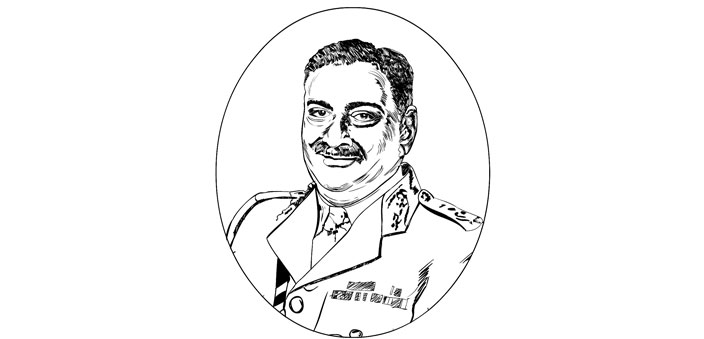A royal commander (1899-1964)
Rajendrasinhji Jadeja was born on 15 June 1899 at Srodar in the Kathiawar region. The family belonged to the ruling family of Nawanagar State (now Jamnagar). He was the third son of Devsinhji Jadeja who was the uncle of K.S. Duleepsinhji, the cricket luminary. He studied at Rajkumar College, Rajkot, and deciding on a military career, joined the Royal Military Academy, Sandhurst, on 10 September 1919. He was the first Indian to be commissioned from Sandhurst and joined the 3rd Battalion of 60 Rifles King’s Royal Rifle Corps in 1921. A year later, he was transferred to the 2 Royal Lancers. He got married to Maya Kunwarba in 1928, and had three children.
In February 1941, the unit sailed to North Africa. It was part of the 3rd Indian Motor Brigade. The Brigade was deployed at Mechili. Vastly superior German and Italian columns surrounded it on all sides on 7 April. Two ultimatums from the German Army calling for surrender were rejected. The last ultimatum offering “honour of war” and signed personally by Erwin Rommel, a highly decorated officer in World War 1 was also rejected. The Brigade was ordered to withdraw to El Adem and two squadrons under Major Rajendrasinhji were assigned the task of rear guard. When Rajendrasinhji learnt that HQ 2 Armoured Division which was in the same location had surrendered, he decided to break out on his own. He charged straight through a battery of enemy guns. After shaking off pursuit, they hid in the nearby hills for the rest of the day. Next morning, the column suddenly came upon an enemy harbour. The Germans were so taken aback that they surrendered without firing a shot. Rajendrsinhji decided to take two lorry loads of prisoners and deprived the rest of fuel and water. He was awarded DSO (Distinguished Service Order) for courageous leadership under enemy action. He was the first Indian officer to be so honoured. He was also the first Indian officer to be posted as Military Attaché in Washington in 1945.
A large number of British officers had left after Independence, resulting in quick promotions for Indian officers. He was appointed General Officer Commanding-in-Chief of Southern Command in 1948. Widespread violence against Hindus was reported from Hyderabad State which had not acceded to India. The Nizam was trying for Independence with the help of Pakistan, and had started importing arms through clandestine channels. It was decided to carry out a police action. Vested interests warned against any military action and exaggerated reports of Hyderabad State forces were circulated. General Bucher, Commander-in-Chief (C-in-C), India, advised against any misadventure as the Indian Army was fully committed in Kashmir. In his view, the Hyderabad Army could inflict large casualties and engage the Indian Army in long drawn out guerrilla operations. He warned that Hyderabad had acquired planes and could bomb Mumbai. Sardar Patel replied that if UK could stand up to the blitz from Luftwaffe, so can Mumbai. He relied on the advice of Rajendrasinhji with whom he had a long discussion and was convinced that the operation could be carried out with speed and little loss of life. On his advice, the cabinet gave a go ahead. Rajendrasinhji opted for advance from the West and East as the southern approach involved logistic difficulties. The Police action started on 17 September and the Hyderabad Army collapsed in 100 hours. The State was integrated into India.
Nationalisation of the armed forces had progressed rapidly. Some people in the government suggested the name of Rajendrasinhji to be the first Indian to be C-in-C . When this was verbally communicated to Rajendrasinhji, he correctly advised that the honour should go to the senior most Indian officer, General (later Field Marshal) K.M.Cariappa The President assumed the role of C-in-C on 31 March 1955, and General Rajendrasinhji became the Chief of Army Staff (COAS), another first in his career. He retired on 14 May 1955. He passed away on 1 January 1964.

